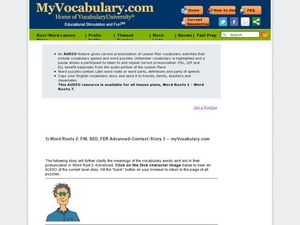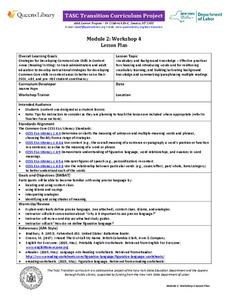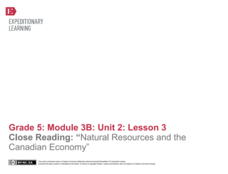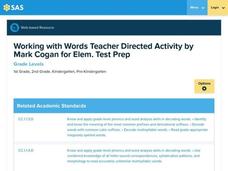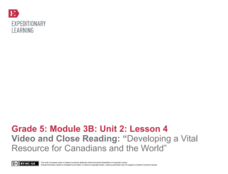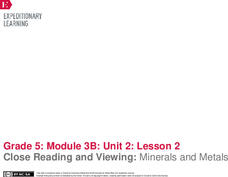EngageNY
Mid-Unit 1 Assessment: Figurative Language and Word Choice in Bud, Not Buddy (Chapter 5)
Individuals utilize the strategies practiced in the previous lesson to complete a mid-unit assessment on figurative language and how Christopher Paul Curtis uses word choice to create meaning in Bud, Not Buddy.
EngageNY
Grade 11 ELA Module 2: Unit 1, Lesson 7
Give the class some clarification. Scholars determine how Du Bois develops his central ideas in the chapter "Of Our Spiritual Strivings" by refining and clarifying his ideas. They organize their thoughts by annotating and recording the...
Curated OER
Mystery Words
In this language arts lesson, 8th graders verify the meaning of a word in its context, even when its meaning is not directly stated. After a class discussion on how to use context clues, students pairs are given a worksheet of "mystery...
Curated OER
Using Context
Teams practice decoding and using context strategies to determine the meanings of unfamiliar words. After verifying the meanings of words through the use of dictionaries, the Internet, thesauruses, and other sources, learners write the...
Curated OER
Predict and Clarify with The Old Woman & Her Pig
Primary readers predict and check for understanding by using comprehension strategies. Prepare readers the first day by frontloading vocabulary and using pictures to visualize the words. On the second day, read the story The Old Woman...
Curated OER
Choose Your Words Wisely
Improve word choice! Writers use dictionaries and thesauruses to aid them in choosing exciting words to incorporate in their writing. They rewrite sentences and practice identifying words that can be replaced using a better word. Flip...
Curated OER
Latin Roots fin, sed, fer: Context Story (Advanced)
Several vocabulary words are joined together in a cohesive paragraph that can be played via audio clip for your class. Pauses in the audio allow listeners to repeat the target words to emphasize correct pronunciation. As the audio is...
Curated OER
Confounding Words
Eleventh graders gain understanding of how words in the English language are formed. They assess their own work for sentence clarity and variety of expression. They increase their comprehension and recall.
Curated OER
Martin's Big Words
Martin's Big Words, by Doreen Rappaport, is a story about Martin Luther King. Encourage your learners to create a list of questions before beginning the reading. Also, learners should be working on monitoring and clarifying to ensure...
Curated OER
Connotation and Denotation: How Word Choice Affects a Paragraph
Review the terms denotation, connotation, diction, and mood in paragraph writing. After defining the terms, middle schoolers practice writing examples of both connotation and denotation. They complete a connotation and denotation graphic...
New York State Education Department
TASC Transition Curriculum: Workshop 4
Why is it important to use precise language? Participants explore this question in the fourth activity in a series of 15 on effective instruction. Perfect for all content areas, the activity promotes appropriate language choice through...
EngageNY
Close Reading: “Natural Resources and the Canadian Economy”
Readers continue to learn how natural resources are important to Canada's economy. They read, annotate, and answer text-dependent questions about Natural Resources and the Canadian Economy. They then discuss key terms in the text.
Alabama Learning Exchange
Compound Words
Learners identify compound words in the story, "Once There Was A Bull." They work with a partner to discuss what makes up a compound word and participate in a game that helps them to understand the concept better. As the assessment...
Curated OER
Reading Word Recognition, Fluency, and Vocabulary
Eleventh graders analyze words that derive meaning from Greek, Roman, and Norse myths. In this myth vocabulary lesson, 11th graders work in learning groups as visual learners, kinesthetic learners, and artistic learners to identify the...
Pennsylvania Department of Education
Working with Words Teacher Directed Activity by Mark Cogan for Elem. Test Prep
Young scholars build word families. In this interactive language arts activity, students visit a website where they play a game creating word families. Young scholars may print out their work when finished.
Curated OER
Reading For Meaning
Select an article that explores people of another culture. After reading it as a class, distribute copies of this worksheet. It asks for a brief summary, encourages readers to make text-to-self connections, and asks learners to identify...
Curated OER
Phineas Gage: Notecard Vocabulary Strategy
Understanding the vocabulary in a text, especially a text like Phineas Gage: A Gruesome but True Story About Brain Science that includes quite a few technical terms, can be the key to understanding the text as a whole. Learners focus on...
ReadWriteThink
Literature Circles: Getting Started
Make reading more enjoyable and interactive with literature circles! Here you'll find detailed lessons to begin the literature circle process. Ten lessons introduce each role learners take on. Literature circle roles include...
Curated OER
Leveled Vocabulary for And Then There Were None
Chaotic, perjury, tenacious, vague, predatory, idiosyncrasy. Using Marzano and Brown’s six steps of direct instruction for vocabulary (choose, restate, illustrate, use, discuss, play) readers of And Then There Were None engage in a...
Curated OER
Comprehension: Vocabulary - Wonderful Words
While reading Chapter 8 of Number the Stars, learners write down any words they encounter in their reading that they find interesting, strange, or confusing. They record why they chose each word, and after completing the reading...
EngageNY
Mid-Unit Assessment: Text-Dependent and Short Answer Questions: Excerpts from “A Limited Supply”
There's no such thing as an unlimited resource. Scholars complete a mid-unit assessment by reading A Limited
Supply. They answer text-dependent questions and complete a graphic organizer about key terms in the text.
Curated OER
Vocabulary Self-Collection Strategy
Dedicate one or two class periods to creating a class glossary of geometry terms. Many geometry terms also appear in our every day vocabulary, but they have very different meanings. For example, the word gross in geometry is very...
EngageNY
Video and Close Reading: “Developing a Vital Resource for Canadians and the World”
Scholars watch Developing a Vital Resource for Canadians and the World to learn about the supplement potash that helps plants grow. They watch the video several times, completing a note catcher to record key ideas along the way. Pupils...
EngageNY
Close Reading and Viewing: Minerals and Metals
How easy is it to live off the land? Scholars read Minerals and Metals in Your Life and discuss how Canada's natural resources meet the needs of the people. Pupils watch a brief video and discuss the gist of the text and video. They then...








